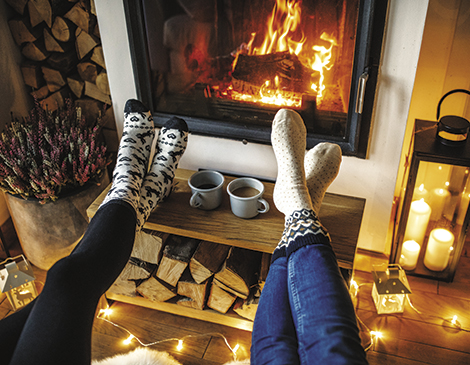These chilly December days are remedied by comfy clothes, hot cocoa and dancing firelight. But anyone who has played with fire knows it’s not as simple as popping in a log. From checking for repairs to maintaining it with regular cleaning, the charming home aesthetic of a fireplace deserves some attention beyond the four to five months it’s in use. Modern Day Chimney owner Robert Jones sheds some light on the subject, so your warm novelty doesn’t go up in smoke.
Check it out
Before you even touch your new home’s fireplace, Jones advises getting the chimney checked out, regardless if the home is fairly new or more than 101 years old. “A lot of times we run the camera up we find holes in the mortar joints, cracked tiles or missing tiles. Just because a fireplace looks brand new and all nice on the outside, it could be a train wreck on the inside,” Jones says.
Keep it clean
Once you made any necessary repairs or fixes, Jones recommends getting your chimney cleaned every 60 fires, which equates to using the fireplace three to two times a week per season. “The most important part of it is the safety of the fireplace itself,” he says. “It’s better to just have it looked at every year.”
Use the right wood
No, you can’t use your Christmas tree as kindling. But in general, most wood will work. The key is to make sure it’s been seasoned — or dried out — for a year or two before being burned. “You don’t want to cut down a tree in June and burn it in September because it is just going to smolder,” Jones says.
Keep tools nearby
Having a fire extinguisher, shovel and poker are intrinsic to fireplace ownership. When cleaning piled-up ash, first make sure you dampen the ash and then use the appropriate filter on your vacuum so the rest of the house doesn’t look like a smoke screen. A nonflammable rug is another good idea. “You should always have a fire-retardant rug, at least 5-by-6 inches, in front of the fireplace,” he says.
Combat down draft
Efficient homes are great. Until cold air snuffs out any attempts to build a fire. When the house is sealed so well, its furnace and hot water tank begin to pull air from the chimney for their own ventilation. The solution is simple. “Open up a window,” Jones says, “that down draft will stop.” With rising heat, the draw is reversed, and the window can be closed again once the fire is going.




